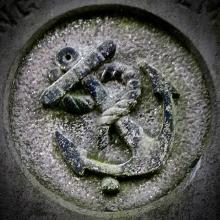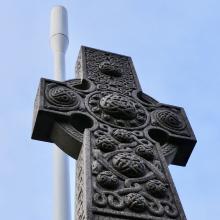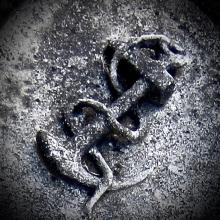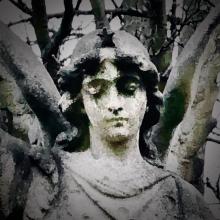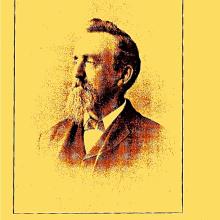
In Rosebank Cemetery, an inscription ends:
SERENE HE SLEEPS
WHOSE SONGS OF LOVE AND HOME
HAVE OFTEN CHEERED US ON THE WORLD’S HIGHWAY;
AND HERE WE LEAVE HIM – WHILE WE ONWARD ROAM –
TO WAIT THE DAWNING OF AN AMPLER DAY.
Here is ‘da last noost’ (winter berth) of Laurence James Nicolson, a native of Lerwick born on 26 April 1844. The youngest of four children born to Shetland parents (his father was a dealer in spirits and malt liquors), he was educated locally before leaving for the mainland.
It is as a minor poet and lyricist that he is remembered today, and mainly for his descriptions of ‘home’ recalled across miles and time: Viking forebears; wild land, sky and sea; common people’s noble emotions. This he did sometimes in local dialect – earning for himself the title ‘Bard of Thule’ from a fellow poet which also figures on his headstone. But his range of interests and tones, and his physical absence from his birthplace, make him atypical of the 19th-century ‘Shetlandic School’.[img_assist|nid=1486|title=|desc=|link=node|align=right|width=161|height=200]
Then, as now, poetry rarely paid, and one can track more of his professional career through Post Office Directories (PODs) and various official records than through bibliographies and reviews. Nicolson first appears locally in the 1861 Census, living with his widowed mother and siblings in Croft Street, Dalkeith. He was at that time 18 years old, and employed as an apprentice cabinetmaker. He probably maintained a domestic or business presence there for some time afterwards as a fully fledged cabinetmaker (although POD, 1869–70 and Marriage records disagree over whether he lived here or at 3 Gray’s Place in Edinburgh). Shetlopedia claims Nicolson worked as a clerk in the Burgh Engineer's office, but does not say where or when. Birth records of 1875 are also vague, describing him simply as a 'builder's clerk'.
Nicolson married Janet Martin, an Edinburgh-born lady's maid, on 17 April 1869, and their first child – Hugh Campbell – was born soon after on 30 July that same year. He would die of scarlet fever 3 days before his third birthday, and become the subject of Nicolson's touching farewell 'Hugo'. The last two lines of the latter – 'And then, mayhap, when I too fall asleep, / I'll wake again, and meet thee at the dawn' – are quoted on Nicolson's own headstone, although in their original context are not religiously orthodox.
Two more children followed in quick succession. First came Lawrance [sic] James in 1873, born back at the Croft Street house in Dalkeith; then Eleanor Campbell, born in her maternal grandparents' home at 11 Brown Street in Edinburgh in 1875. She too died young, of tubercular meningitis, aged 9 months; and is remembered in her father's poem 'Nellie'. A third poem on infant mortality – 'In Memoriam' – is to my mind the best of the lot. It is reproduced below.[img_assist|nid=1455|title=|desc=|link=node|align=right|width=144|height=200]
Nicolson is listed for the first time as a ‘traveller’ resident at 20 Heriot Place in 1879–80, then from 1881–2 to 1884–5 around the corner at 11 Keir St (a ‘commercial traveller, tobacco’ according to the 1881 Census). It was here that Nicolson's fourth child – William Campbell – was born in 1883. A member of the Leith Thule Club at 38 Constitution St, from 1888–9 to 1890–1 Nicolson lived at 16 East Norton Place, and from 1893–4 – still as a ‘commercial traveller’ – nearby at 32 Hillside St. From 1894–5 to 1896–7 he resided at 36 Montgomery St; in 1897–8 at 13 Union St; from 1898–9 to 1900–1 at 14 Broughton Place (pictured above right); and in a final POD entry for 1901–2 he is given at 17 Hart St (pictured right).
These short geographical steps reflect uneven, precarious progress up the economic ladder. In their first Edinburgh Census appearance in 1881, Nicolson lived with Janet and son Laurence. Ten years later, son William had arrived, and the four of them resided in East Norton Place with a sister-in-law, nephew, and servant. By 1901, the wife and children remained a unit, the sons single and employed as a barman and litho artist respectively. The family retained a housemaid. [img_assist|nid=1454|title=|desc=|link=node|align=right|width=229|height=640]
When Nicolson’s collected Songs of Thule were published by A. Gardner of Paisley in 1894, it must have felt like a thrilling vindication of his underpaid second life. But publication was also tinged by paradox.
‘The Bard of Thule’ had not been a title of his own choosing. His published dialect was not particularly authentic since he had diluted it in order to reach as wide an audience as possible. Indeed, for Nicolson, of equal if not greater interest to celebrating his ‘fatherland’ had been a concern to express socialist and atheistic principles in standard English and Scots (see below), as in his once scandalous parody of Tennyson’s sycophantic Jubilee ode ‘Carmen Sæculare’ (1887).
Gardner, however, was ‘Publisher to Her Majesty the Queen’ and either omitted or played down the true nature of Nicolson’s sentiments. He emphasised instead Nicolson’s dainty melodiousness, the poet’s ‘heart thrilling under the enthusiasm of humanity’. Other critics focused on his ‘plaintive’ romanticism, his romantic or antiquarian appeal, and the ease with which his verses could be set to the ‘wild’ and ‘untaught chords’ of Shetland ‘violins’. The Tennyson parody did not appear. Gardner coyly described the poet’s radicalism as ‘a patient faith in science and man, the expression of which gives to Mr. Nicolson a somewhat unique position among our song writers’.
Even the Post Office Directory and Census compilers seemed to have unwittingly conspired against the poet’s place in history, frequently muddling the spelling of his forename (Laurence/Lawrence) and in 1891 listing his birthplace as ‘Lerwick, Orkney’. In some ways, Nicolson's frustration was a typical romantic tragedy of the era: he was a working man exalted and uplifted by his art; simultaneously misrepresented – as we shall see, even by friends – in his rise from obscurity.
Nicolson died at 17 Hart Street on 13 July 1901 of cardiac disease and a cerebral embolism. In his latter years he had enjoyed some luxuries; though modestly employed, the family had been able to afford a domestic servant. Typical of the period, however, the fact that Nicolson’s headstone was erected ‘by a few friends’ suggests that any apparent affluence concealed extremely tight financial margins of error. Janet survived him till 1906 and is buried in the same lair.
Nicolson's emergence from very modest economic and culturally remote circumstances into a limted metropolitan limelight is admirable. However, even his headstone reflects contemporary tensions about his beliefs and reputation: its (encoded atheist) pseudo-Egyptian details at odds with its inscription's (by implication Christian) promise of an 'ampler day'. Whoever chose these words stopped short of including standard religious sentiments of the period, but still rendered uncontentious one who in life was very far from conventional. AM
DA LAST NOOST
('Noost' is the place to which a Shetland boat is drawn up in
winter.)
A SANG, annkler sang, ye say,
An' if it be da last,
Need I be wae? I'm haed my day,
An' noo dat day is past.
My day is dune, what need I care?
I'm haed him foul, I'm haed him fair;
An sae, auld boat, for dee an' me
Nae mair, nae mair, da heavin' sea.
Du wis a boat o' boats da best,
Troo mony a storm we drave;
Noo in da Noost, du taks da rest
We never mair will laeve.
Last haven, freend, for dee an' me,
For we're cross'd owre Life's changin' sea;
We set oot wi' nae little trust,
An' noo it ends in dael an' dust.
When dee an' me, dat day in
Broucht hame my bonnie bride,
My hert sung oot a blyde, blyde tune,
Du danc'd ipo da tide.
Ah ! Life an' Love wis young, an' den
I haed a happy but an' ben;
Du wis my pride ipo the sea,
An' she was da very hert o' me.
Den cam a day o' dule an' care,
Da lift abune wis lead
Across da dreary sea we bare
To her last hame my dead.
My fecht is owre wi' wind an' wave,
Da Noost is noo da quiet grave;
An' sae, auld boat, for dee an' me,
Nae mair, nae mair, da heavin' sea!
IN MEMORIAM
J. C.
A TRIBUTE to thy mem'ry, little friend,
From one who feels a sympathetic sorrow
With those who mourn, and fail to comprehend,
Yet seek from out the darkness, light to borrow.
We stand upon the cold and dreary shore
Of that unfathomed, gloom-enshrouded ocean;
We only hear the sobbing evermore,
That sinks and rises with the waves' commotion.
Yet all the sunshine will not pass away
That lighted thy sweet face, and filled thy spirit;
Nor yet the sound of pattering feet at play,
While we the boon of memory inherit.
The trembling stars of eve, the fairest flowers,
The little warbling birds, the sunset's glory,
And every bright thing in this world of ours,
Will keep forever now thy little story.
SONG OF THE PEOPLE
OURS the learning by disasters,
Ours the grief that maketh wise,
We, the people are the masters,
Tyrants fall when we arise.
Nurtured by long years of wrong,
We are ready, we are strong.
Ho! my brothers we are strong,
Hearts of all that would be free,
Never yet a nobler song,
Led the way to victory.
On our banner line on line,
Freedom, Truth, and Progress shine.
Freedom! all alike may share,
Truth! the pole star overhead.
Progress! higher heights to dare,
Battle cry might rouse the dead.
Ours the fight, our fathers fought,
Shall their strength be spent for nought ?
Can we hold their mem'ry dear,
Yet their sacred cause forego?
Let who will be dumb with fear,
Braver spirits answer no!
Not for class, or great, or small,
But the common good of all.
Rise! my brothers for the right,
Rise! their day is past recall,
Galling fetters in our might
Break asunder once for all.
Ours the hands shall clear the way,
Robe, and crown, the better day.
HEAVEN
Do I believe in heaven? Yes,
It burst upon my sight;
I saw the sacred loveliness,
I basked within the light.
I heard a voice from day to day
Make music of my name,
And over all a glory lay
That told me whence it came.
No city paved with shining gold,
And jewels all bedight;
The heaven I trace a woman's face
Aglow with love's own light.
A woman's heart, a woman's hand,
For all life's ills atone;
Her loving kiss, the raptured bliss,
The paradise I own.
SOURCES
Birth records: Newington, Edinburgh 1869 (685-05/767); Dalkeith, Midlothian 1873 (683/159); Newington, Edinburgh 1875 (685-5/692); St George, Edinburgh 1883 (685-1/1271).
Census records: Lerwick, Shetland 1851 (5/4); Dalkeith, Midlothian 1861 (683-1/22); St George, Edinburgh 1881 (685-1/15); Canongate, Edinburgh 1891 (685-3/12); St Andrew, Edinburgh 1901 (685-2/79).
Death records: Newington, Edinburgh 1872 (685-5/6); 1876 (685-5/350); St Andrew, Edinburgh 1901 (685-2/450).
Edwards, D.H. (DATE) Modern Scottish Poets: with Biographical and Critical Notices, SERIES? (Brechin: D.H. Edwards).
Laurence James Nicolson (1894) Songs of Thule (Paisley and London: Alexander Gardner); also available online at
[http://www.archive.org/stream/songsofthule00nicorich/songsofthule00nicorich_djvu.txt].
'Laurence J. Nicolson', Shetlopedia – the Shetland Encyclopaedia [http://shetlopedia.com/Laurence_J._Nicolson].
Marriage records: Newington, Edinburgh, 1869 (685-5/112).
'Lord Tennyson's Jubilee Ode', Victorian Poetry, Centennial of Queen Victoria's Golden Jubilee (Autumn–Winter) 25 (3/4): 10–24.
Post Office Directories, Edinburgh (1859–60 – 1901–2).
Smith, B. (1996) ‘The Development of the Spoken and Written Shetland Dialect: a Historian's View’, in D.J. Waugh (ed.) and B. Smith (assoc. ed.) Shetland’s Northern Links, Language and History, pp. 30–43 (Edinburgh: Scottish Society for Northern Studies).
